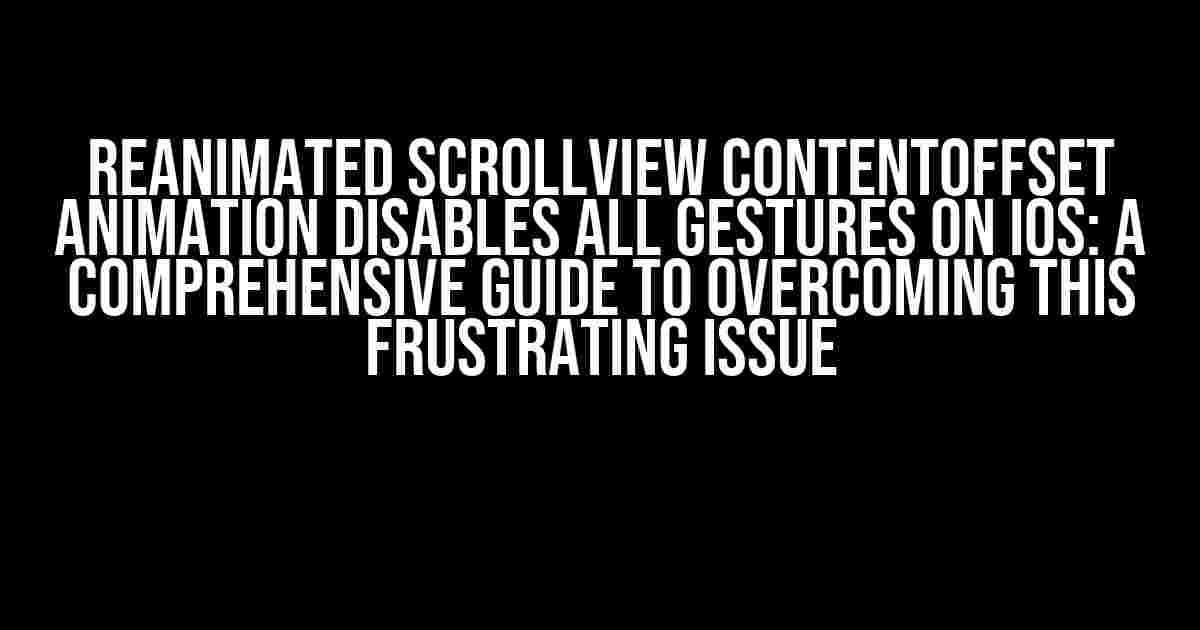Are you tired of dealing with unresponsive gesture recognizers on iOS when using Reanimated and Scrollview together? You’re not alone! The `contentOffset` animation issue has been a thorn in the side of many iOS developers, causing frustration and hours of debugging. Fear not, dear reader, for we’re about to dive into the depths of this problem and emerge with a solution that will get your gestures working smoothly again.
What’s causing the issue?
The root of the problem lies in the way Reanimated and Scrollview interact with each other. When you animate the `contentOffset` property of a Scrollview using Reanimated, it can cause the gesture recognizers to malfunction or even disappear entirely. This is because Reanimated’s animation engine takes control of the Scrollview’s scrolling behavior, overriding the default gesture recognition.
The Role of Reanimated
Reanimated is a popular animation library for React Native that provides a powerful and flexible way to animate components. However, when used with Scrollview, it can sometimes interfere with the default gesture recognition.
import { View, ScrollView } from 'react-native';
import { useSharedValue, withTiming } from 'reanimated';
const offset = useSharedValue(0);
const handleScroll = () => {
offset.value = withTiming(100, { duration: 500 });
};
return (
<ScrollView
onScroll={(e) => handleScroll(e)}
contentOffset={{ x: offset.value, y: 0 }}
>
{/* Your scrollview content */}
</ScrollView>
);
The Role of Scrollview
Scrollview is a fundamental component in React Native that provides a scrollable area for displaying content. It’s essential for building many types of applications, from social media feeds to messaging apps.
By default, Scrollview comes with built-in gesture recognizers that allow users to scroll, tap, and pan through the content. However, when Reanimated takes control of the scrolling behavior, it can disable these gestures, leading to an unresponsive UI.
Solutions to the problem
Now that we’ve identified the root cause of the issue, let’s explore some solutions to get your gestures working again:
Solution 1: Disable Reanimated’s animation during scrolling
One approach is to disable the Reanimated animation while the user is scrolling. This allows the default gesture recognizers to take control, ensuring a smooth and responsive UI.
import { View, ScrollView } from 'react-native';
import { useSharedValue, withTiming } from 'reanimated';
const offset = useSharedValue(0);
const isScrolling = useSharedValue(false);
const handleScroll = () => {
isScrolling.value = true;
offset.value = withTiming(100, { duration: 500 });
};
const handleScrollEnd = () => {
isScrolling.value = false;
};
return (
<ScrollView
onScroll={(e) => {
if (!isScrolling.value) {
handleScroll(e);
}
}}
onScrollEndDrag={() => handleScrollEnd()}
contentOffset={{ x: offset.value, y: 0 }}
>
{/* Your scrollview content */}
</ScrollView>
);
Solution 2: Use a custom gesture recognizer
Another solution is to create a custom gesture recognizer that captures the user’s gestures and forwards them to the Scrollview. This approach requires more code, but it provides a high degree of customization.
import { View, ScrollView, PanResponder } from 'react-native';
const panResponder = PanResponder.create({
onStartShouldSetPanResponder: () => true,
onPanResponderGrant: () => console.log('Pan responder granted'),
onPanResponderMove: (e, gestureState) => {
// Forward the gesture to the Scrollview
console.log('Pan responder move', gestureState);
},
onPanResponderRelease: () => console.log('Pan responder released'),
});
return (
<ScrollView
{...panResponder.panHandlers}
>
{/* Your scrollview content */}
</ScrollView>
);
Solution 3: Use a third-party library
If you’re short on time or prefer a more plug-and-play solution, consider using a third-party library like `react-native-gesture-handler`. This library provides a comprehensive set of gesture recognizers that can be easily integrated with Reanimated and Scrollview.
import { View, ScrollView } from 'react-native';
import { TapGestureHandler } from 'react-native-gesture-handler';
const handleTap = () => console.log('Tap recognized');
return (
<TapGestureHandler onGestureEvent={handleTap}>
<ScrollView>
{/* Your scrollview content */}
</ScrollView>
</TapGestureHandler>
);
Conclusion
In conclusion, the `contentOffset` animation issue in Reanimated and Scrollview can be overcome with a combination of clever coding and creative problem-solving. By understanding the root cause of the problem and applying one of the solutions outlined above, you can restore the default gesture recognizers and provide a smooth, responsive UI for your users.
| Solution | Description | Complexity |
|---|---|---|
| Disable Reanimated’s animation during scrolling | Disable the Reanimated animation when the user is scrolling | Low |
| Use a custom gesture recognizer | Create a custom gesture recognizer that captures the user’s gestures and forwards them to the Scrollview | Medium |
| Use a third-party library | Use a third-party library like `react-native-gesture-handler` to provide a comprehensive set of gesture recognizers | High |
Remember, the key to overcoming this issue is to understand the underlying mechanics of Reanimated and Scrollview, and to be willing to experiment and try different approaches until you find the one that works best for your specific use case.
FAQs
-
Why does Reanimated’s animation disable the gesture recognizers?
Reanimated’s animation engine takes control of the Scrollview’s scrolling behavior, overriding the default gesture recognition. This is because Reanimated is designed to provide a high degree of customization and flexibility, but it can sometimes interfere with other components.
-
Can I use Reanimated with other scrollable components?
Yes, you can use Reanimated with other scrollable components, such as FlatList or ViewPager. However, the same issue may arise, and you may need to apply similar solutions to overcome it.
-
Are there any performance implications of using a custom gesture recognizer?
Yes, using a custom gesture recognizer can have performance implications, especially if it’s not optimized correctly. Make sure to test and profile your code to ensure it meets your performance requirements.
We hope this comprehensive guide has helped you overcome the frustrating issue of Reanimated’s `contentOffset` animation disabling all gestures on iOS. Happy coding!
Frequently Asked Question
Get the inside scoop on reanimated scrollview contentOffset animation and its impact on gestures in iOS.
Why does reanimated scrollview contentOffset animation disable all gestures on iOS?
Reanimated scrollview contentOffset animation can disable all gestures on iOS due to a known issue in the Reanimated library. When you animate the contentOffset property, it can block the gesture recognizers, leaving your users unable to interact with the scroll view.
Is this a bug in the Reanimated library?
While it might seem like a bug, it’s actually an intended behavior of the Reanimated library. The animation takes priority over gesture recognizers to ensure a smooth animation experience. However, this can lead to unintended consequences, like disabling gestures.
Can I use a different animation library to avoid this issue?
Yes, you can explore alternative animation libraries like Lottie or React Native Animations. These libraries might not have the same issue, but keep in mind that you’ll need to rewrite your animation code to work with the new library.
Are there any workarounds to enable gestures during the animation?
One possible workaround is to use a timer to pause the animation briefly, allowing gestures to take precedence. Another approach is to use a separate, gesture-enabled scroll view on top of the animated one. However, these workarounds can be tricky to implement and might not work for every use case.
How can I report this issue to the Reanimated library maintainers?
You can create an issue on the Reanimated library’s GitHub page, providing a detailed description of the problem, along with a reproducible example. The maintainers will review your issue and might provide a fix or guidance on how to work around the problem.


